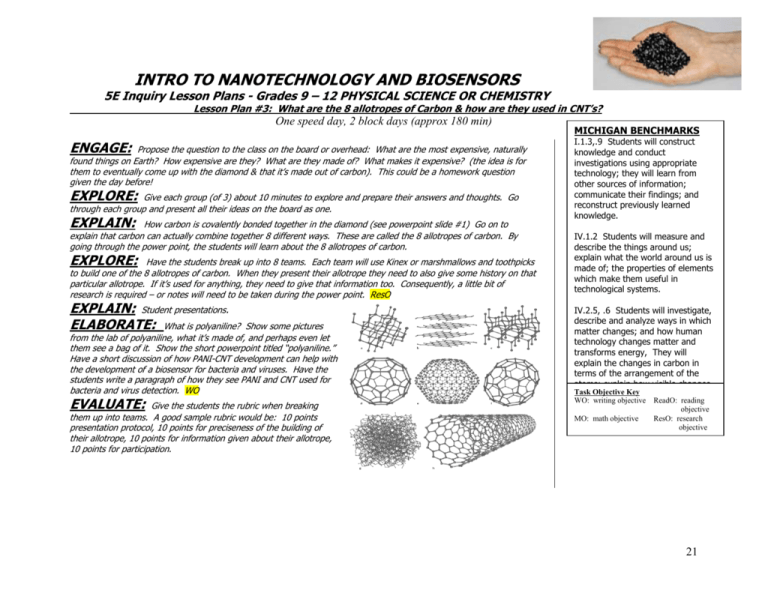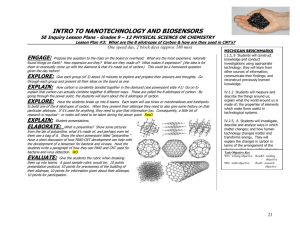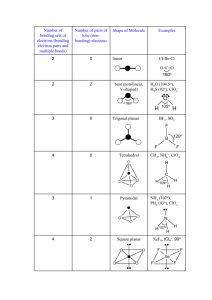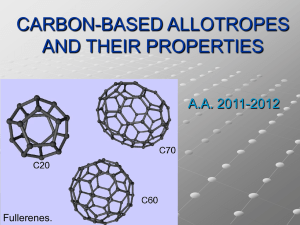Lesson Plan 3
advertisement

INTRO TO NANOTECHNOLOGY AND BIOSENSORS 5E Inquiry Lesson Plans - Grades 9 – 12 PHYSICAL SCIENCE OR CHEMISTRY Lesson Plan #3: What are the 8 allotropes of Carbon & how are they used in CNT’s? One speed day, 2 block days (approx 180 min) ENGAGE: Propose the question to the class on the board or overhead: What are the most expensive, naturally found things on Earth? How expensive are they? What are they made of? What makes it expensive? (the idea is for them to eventually come up with the diamond & that it’s made out of carbon). This could be a homework question given the day before! EXPLORE: Give each group (of 3) about 10 minutes to explore and prepare their answers and thoughts. Go through each group and present all their ideas on the board as one. EXPLAIN: How carbon is covalently bonded together in the diamond (see powerpoint slide #1) Go on to explain that carbon can actually combine together 8 different ways. These are called the 8 allotropes of carbon. By going through the power point, the students will learn about the 8 allotropes of carbon. EXPLORE: Have the students break up into 8 teams. Each team will use Kinex or marshmallows and toothpicks to build one of the 8 allotropes of carbon. When they present their allotrope they need to also give some history on that particular allotrope. If it’s used for anything, they need to give that information too. Consequently, a little bit of research is required – or notes will need to be taken during the power point. ResO EXPLAIN: Student presentations. ELABORATE: What is polyaniline? Show some pictures from the lab of polyaniline, what it’s made of, and perhaps even let them see a bag of it. Show the short powerpoint titled “polyaniline.” Have a short discussion of how PANI-CNT development can help with the development of a biosensor for bacteria and viruses. Have the students write a paragraph of how they see PANI and CNT used for bacteria and virus detection. WO EVALUATE: Give the students the rubric when breaking them up into teams. A good sample rubric would be: 10 points presentation protocol, 10 points for preciseness of the building of their allotrope, 10 points for information given about their allotrope, 10 points for participation. MICHIGAN BENCHMARKS I.1.3,.9 Students will construct knowledge and conduct investigations using appropriate technology; they will learn from other sources of information; communicate their findings; and reconstruct previously learned knowledge. IV.1.2 Students will measure and describe the things around us; explain what the world around us is made of; the properties of elements which make them useful in technological systems. IV.2.5, .6 Students will investigate, describe and analyze ways in which matter changes; and how human technology changes matter and transforms energy, They will explain the changes in carbon in terms of the arrangement of the atoms; explain how visible changes Task Objective in matter are Key related to atoms and WO: writing objective ReadO: reading molecules and related to energy objective changes. MO: math objective ResO: research objective 21 Allotropes of Carbon PROJECT Your goal is to make a poster and do a presentation to the class on your allotrope of carbon. Most of your research will be done on the internet. There will be a few copies of the powerpoint presentation you can check out for the hour to help with your research. The following is a list of things you will want to research. • Explain more about the crystal structure of your allotrope • IF NATURAL: o Where on earth is it found?. o How did it form and get there? o What is it used for? • IF SNYTHETIC (man made): o Who first created this allotrope? o What motivated them to create it? o What are they using it for? • Build a model of your allotrope using marshmallows and toothpicks • Use photos and/or graphics on your poster. • Each person should say something during your 3-5 minute presentation PRESENTATION PROTOCOL: • Introduce your product • Each person will then introduce themselves • Each person takes their turn talking about your product • Ask the class for “questions” CARBON ALLOTROPE PRESENTATION POINTS EARNED Aesthetics & use of graphics on Poster (10) ________ Presentation Protocol (10) ________ Detail & preciseness of explanation/information (10) ________ Model of your atom (10) ________ __________________________________________________________________ Team Member 1 Team Member 2 Team Member 3 Team Member 4 Participation (10) Participation (10) Participation (10) Participation (10) Name: Points: TOTAL POINTS AWARDED 22 Slide 1 Slide 2 DIAMONDs are forever! ¾Each black ball is a carbon atom ¾It tends to form a cubic lattice ¾It’s the hardest known natural The Engage phase leads nicely into the first slide – be sure to use this opportunity to your fullest mineral ¾It has a high dispersion of light ¾80% of mined diamonds are for industrial use as they are not of jewelry quality. ¾What do they use them for in industry? Slide 3 Carbon doesn’t always form into the shape of a cubic lattice. • In Fact, there are 8 different allotropes of carbon. 23 These are the 8 different allotropes. Ask the students to tell you which one is the diamond. Slide 4 Slide 5 Graphite • • • • • In Greek: “to draw/write” A conductor The most stable Is used in pencils Carbon forms in Hexagonal planes Slide 6 24 Slide 7 Lonsdaleite • Identified in 1967 in a meteorite found in an Arizonan crater • Believed to be originally graphite • due to the heat and pressure upon impact, it turned to diamond but kept the crystal structure of graphite Slide 8 Slide 9 FULLERENES Discovered “in” 1985 • Discovered in 1985 by • • • • • a team of scientists from the US and England Shape of a hollow sphere Referred to as “buckyballs” Also known as C60. Why? Use nano-technology to combine the atoms in this way Hopeful for use in tackling melanoma and other tough cancers 25 Slide 10 Slide 11 C540 allotrope • Like all fullerenes, C540 is a hollow spherical shape created using nanotechnology. • How many atoms of carbon are in it? Slide 12 26 Slide 13 C70 • Another Nanotech creation • What do all Fullerenes have in common? Slide 14 Slide 15 Amorphous Carbon (Coal & soot) • Does not have any visible crystal structure or atomic arrangement of carbon atoms • Is found containing crystallites of graphite and diamond (so small, it’s often nano size) • Coal has different grades ranging from 55% - 90% pure carbon 27 Slide 16 Slide 17 CARBON NANOTUBES Stronger than diamonds Conduct heat well Can be made as either a conductor or semiconductor Slide 18 CNT’s (Carbon NanoTubes) are now used for or being researched for…… • Clothes – waterproof, tear resistant cloth fibers • Military Combat Jackets – the ultra strong CNT fibers will monitor the condition of the soldier • Concrete – increases tensile strength and eliminates cracks • Polyethylene plastics • Sports equipment – lighter & stronger equipment as seen • • • • • • • previously Space Elevator – possibly! It’s in the planning stages Artificial muscles Paper LCD screens Nano wires Computer circuits Air and water filters 28 Slide 19 Slide 20 Phase Diagram for Carbon This is an extra slide of interest. The students found this chart interesting and several used it in their presentations Slide 21 Carbon on the Periodic Table 29 Slide 22 REFERENCES • http://webmineral.com/specimens/picshow.p hp?id=2926 (lonsdaleite image) • http://en.wikipedia.org/wiki/Wikipedia:Featur ed_picture_candidates/Six_Allotropes_of_Car bon • http://en.wikipedia.org/wiki/Image:Eight_Allo tropes_of_Carbon.png • http://www.answers.com/topic/fullerene • http://en.wikipedia.org/wiki/Carbon_nanotub e • http://en.wikipedia.org/wiki/Polyaniline Slide 23 Assignment • Divide into 8 groups as listed on the lab tables • You will be then assigned an allotrope of carbon to make with the kinex or marshmallows (ck funding) • You will be given the appropriate number of pieces to make your allotrope • Present your allotrope with some information on a poster board about it which you’ve researched on the internet! 30 FIGURE 2: Photos of Carbon Allotrope Models and Poster (Below Left) A Carbon Nanotube (CNT). In the back left is the Lonsdaleite Allotrope. (Above) A C70 Allotrope held together with a cola bottle (Right) Amorphous Coal and Soot is in the back left. Back right is another CNT, and in front is a C60 Buckyball in progress. 31 (Below) C540 Buckyball made with a paper mache interior. (Above) A C70 Buckyball made with a soccer ball interior. (Right) A C60 Buckyball project in progress. Students cut out a combination of pentagons and hexagons to fit together to create the interior of the C60. In the background is a CNT model and several posters. 32 (Below) C540 Allotrope: Students used an exercise ball to hold their model together. 33 8 Allotropes of Carbon DIAMONDs are forever! ¾Each h bl black k ball b ll is i a carbon b atom ¾It tends to form a cubic lattice ¾It’s It’ th the h hardest d tk known natural t l mineral ¾It has a high dispersion of light ¾80% of mined diamonds are for industrial use as they are not of jewelry quality. ¾What do they use them for in industry? Carbon doesn’t always y form into the shape of a cubic lattice. • In Fact, Fact there are 8 different allotropes of carbon. Graphite • • • • • In Greek: “to draw/write” / A conductor The most stable Is used in pencils Carbon forms in Hexagonal planes Lonsdaleite • Identified in 1967 in a meteorite found in an Arizonan crater • Believed e e ed to be originally graphite • due to the heat and pressure upon impact, it turned to diamond but kept the crystal structure of graphite FULLERENES • Discovered 1985 by • • • • • a team of scientists from the US and England Shape of a hollow sphere Referred f to as “buckyballs” Also known as C60. Why? Use nano-technology nano technology to combine the atoms in this way Hopeful p for use in tackling g melanoma and other tough cancers C540 allotrope • Like all fullerenes, C540 is a hollow spherical shape g created using nanotechnology. • How manyy atoms of carbon are in it? C70 •A Another th Nanotech creation ti • What do all Fullerenes have in common? Amorphous Carbon (Coal & soot) • Does not have any visible crystal structure or atomic arrangement of carbon atoms • Is found containing crystallites of graphite and d diamond di d (so ( small, ll it’s often nano size) • Coal has different grades ranging from 55% - 90% pure carbon b CARBON NANOTUBES Stronger than diamonds Conduct heat well Can be made as either a conductor or semiconductor CNT’s ((Carbon NanoTubes)) are now used for or being researched for…… • Clothes – waterproof, tear resistant cloth fibers • Military Combat Jackets – the ultra strong CNT fibers will • • • • • • • • • • monitor the condition of the soldier Concrete – increases tensile strength and eliminates cracks Polyethylene plastics Sports equipment – lighter & stronger equipment as seen previously S Space El Elevator t – possibly! ibl ! It’s It’ iin the th planning l i stages t Artificial muscles Paper LCD screens Nano wires Computer circuits Air and water filters Phase Diagram g for Carbon Carbon on the Periodic Table REFERENCES • http://webmineral.com/specimens/picshow.p hp?id=2926 p ((lonsdaleite image) g ) • http://en.wikipedia.org/wiki/Wikipedia:Featur ed_picture_candidates/Six_Allotropes_of_Car bon • http://en.wikipedia.org/wiki/Image:Eight_Allo tropes_of_Carbon.png • http://www.answers.com/topic/fullerene • http://en.wikipedia.org/wiki/Carbon_nanotub e • http://en.wikipedia.org/wiki/Polyaniline Assignment • Divide into 8 groups as listed on the lab tables • You will be then assigned an allotrope of carbon to make with the kinex or marshmallows (ck funding) • You will be given the appropriate number of pieces to make your allotrope • Present your allotrope with some information on a poster board about it which you’ve researched on the internet!







